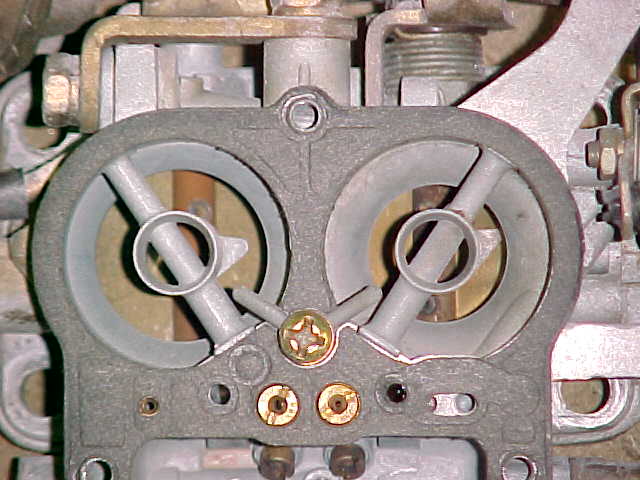
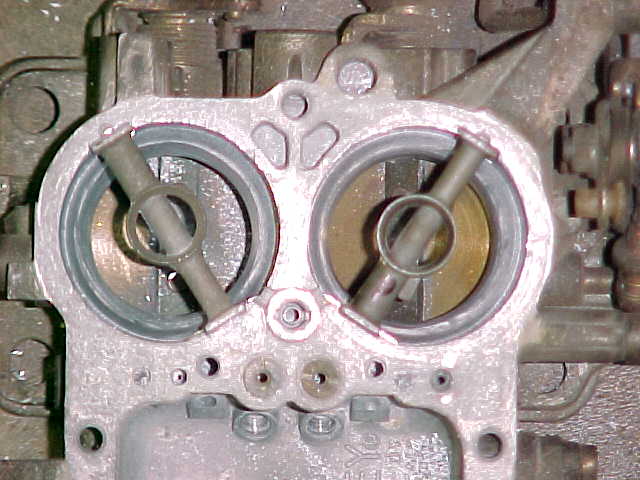
Chevette carb modifications
It will take a while for the photos
to load, please be patient. Thank you !
(Photos were kept small to enhance load time )
Hi ! I thought some of you might be interested in some modifications I will be doing to some Chevette carbs this spring for the local racers, so I whipped this page up pretty fast. Take a look at the pictures below:


You might take note that the carb on the right has significantly LARGER venturi's. That is a Chevette carb, Holley list 9939 after modification. As you can guess, this carb will probably flow just a bit more air. Of course, the first attempt I made had a little problem:
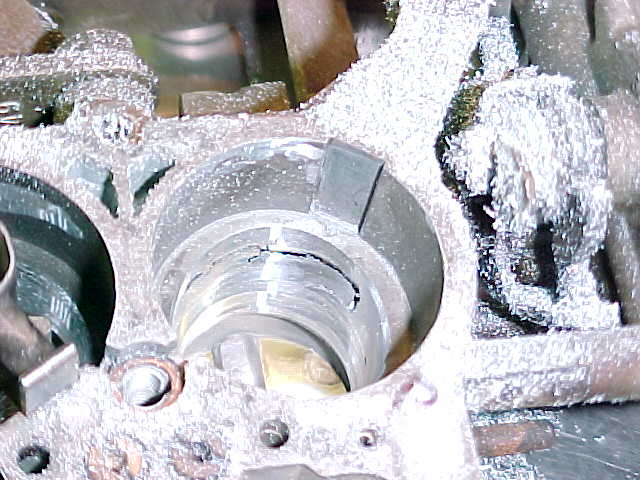
It turns out that the carbs with the extremely small primary venturi won't accept
much modification. :-)
The 9939 that I used on the second attempt has a large primary venturi to begin with. It
is original equipment for the 1980 Chevette, all transmissions w/AC, Federal emissions. I
have some measurements, for example, the small venturi carb started life at about
13/16" before cutting, and could have gone to a little over 1" before busting
through. The large carb was finally enlarged to 1 5/32" ! As this page is
suddenly being composed, I'm doing this from memory, and will be fixing it later.
If you're interested, this is one of the few carbs that have easily removable boosters which is allowing these modifications to be "easily" performed. Just invert the carb, open the throttle, and you can carefully "tap" the boosters out using a long punch or the appropriate tool. I have never seen any that were hard to remove, as a matter of fact, these are usually loose, and some I have simply pulled out the top.
Note the photo below:
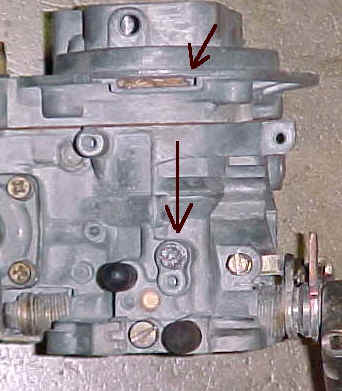
You must plug the hole where the vertical arrow is. ( I used lead shot, easily removed. ) This used to go to the choke pull off in the choke housing. The other arrow is to note where you should insert something to block off the slot in the air horn where the choke rod used to go to the choke shaft. This will not be necessary of course if the choke is retained. As this carb will be used on a race car only, these mods are required.
Note the photo below:
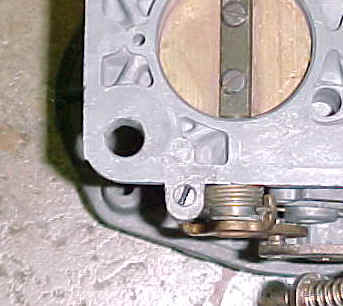
The screw in the center of the photo is the secondary throttle stop screw on the bottom of the Holley 5200 carb.. You can turn this IN slightly to open the rear throttle blade slightly to let a little extra air in for an oversize cam. If you have to adjust the primary idle stop screw open excessively to get a "good idle" because of an oversize cam, you will expose the transfer slot, which will cause the primary air/fuel screw to become non-responsive, and usually cause an off idle flat spot. ( among other bad things. ) In severe cases, it will be necessary to drill holes into the primary throttle blade when the cam is HUGE. I have seen Winston Cup carbs with 4 - ¼" holes, 1 - ¼" hole for each throttle blade ! ( That's a .250" hole for each throttle blade.)
If you need a little more idle fuel because you have a big cam, check out the photo's below:
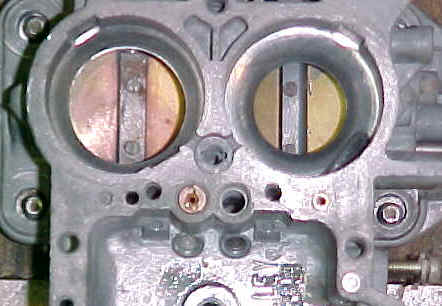
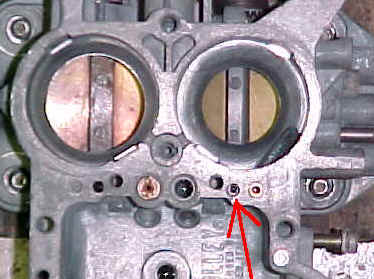
The carb on the right has had the lead shot plug removed exposing the idle pick up tube. This carb had an orifice size of .027. If you need more idle fuel, you can enlarge this SLIGHTLY. Remember, a little means a lot when enlarging a round hole, especially the idle circuit. The brass hole directly on the right of the idle jet is the idle air bleed, leave it alone! Look at the picture below to see what the idle pick up tube looks like, and the highly sophisticated tool used to remove it:
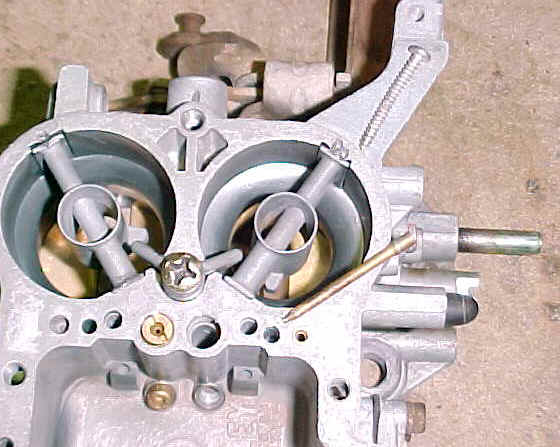
The screw that you see laying there is really all that is needed
to pull the tube. Caution is advised of course. The small opening on the bottom of the
tube is the actually idle orifice, and it is tiny ! You should acquire a wire drill set to
modify these items.
I have been asked what to do about the electric bowl vent. On a street car, I would
suggest leaving it in place and operational. The bowl vent directs fuel vapors to the
evaporation canister, and is a good emission control device. For racing, simply leave it
in place and ignore it. If you want to, remove the components under the air horn,
but leave the upper diaphragm in place along with the cover. Otherwise, you will have a
huge gaping hole in the air horn (top) of the carb. Not good. In the photo below, the
components are placed in order of assembly. The spring, rubber seal, and e-clip go on the
diaphragm stem under the air horn.
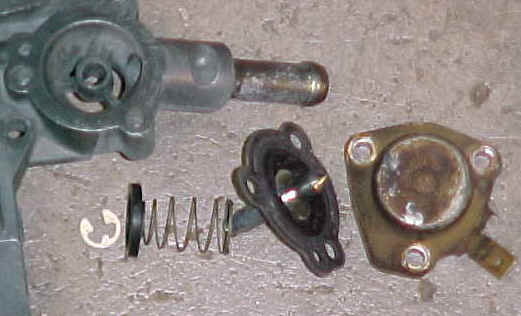
This carb will be tested soon on a dirt track racer:
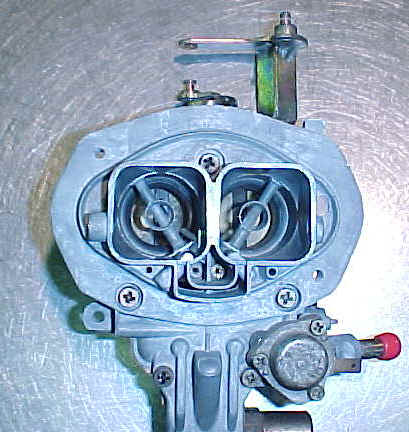
.... and I'll let you know the results. I'm keeping notes on jetting, idle circuit mods, and bleed sizes. If anyone is interested in these mods, or needs further info, keep watching this page, or email me.
* Currently, this carb will be initially tested with jet sizes of .057" primary and .060 secondary. This would equate to a jet with the number "307" on the primary, "330" secondary. I have a 195 bleed on the primary, and a 175 on the secondary. The original jetting for the 9939 Holley was a 199 primary and 283 secondary jet. ( 199 =.047 283 = .056 ). I have not checked what the PVCR ( power valve channel restriction ) is, I would have to remove some lead plugs to do this. This may or may not significantly affect the primary metering. If it was a drag racing car, I would block the PVCR circuit. The idle discharge hole was enlarged to .070 for a better idle quality. ( Big cam, open headers ).
Test results will be provided when available. I don't have a gas Chevette, so must rely on "testers".
Update, April 26, 2001 ! Final calibration results ! ( so far )
All jets are being hand drilled as this is the most expedient method. These jets are difficult to acquire at best, and although I don't like to hand drill jets, it is a viable alternative. Measurements are being taken with a plug gauge set.
The big 5210 Holley 9939 ( as seen above ) is running with:
.060 main jet primary, number 120 bleed
.067 main jet secondary, number 110 bleed
Stock power valve channel restriction
.070 idle jet, stock ICR
No idle air bypass hole ( stock camshaft, not necessary )
No. 50 accelerator nozzle
This carb has had both venturi's increased to 1-5/32" !
The smaller Holley 5210 version is running with:
.052+ main jet primary, number 120 bleed
.059+ main jet secondary, number 100 bleed
Stock power valve channed restriction
.061 idle jet, stock ICR
No idle air bypass hole
No. 50 accelerator nozzle
This carb has had the primary venturi size increased from
13/16" to 1", and the secondary was enlarged to
1- 5/32". These venturi's cannot be made any larger. See above !
These carbs would perform fine on a street engine, as most of these "racing"
engines are using almost entirely stock components. With the addition of a choke assembly,
I would expect nothing short of flawless performance on a street engine, when calibrated
accordingly.
To see costs of getting these modifications performed, click here.
Further updates to occur as necessary.